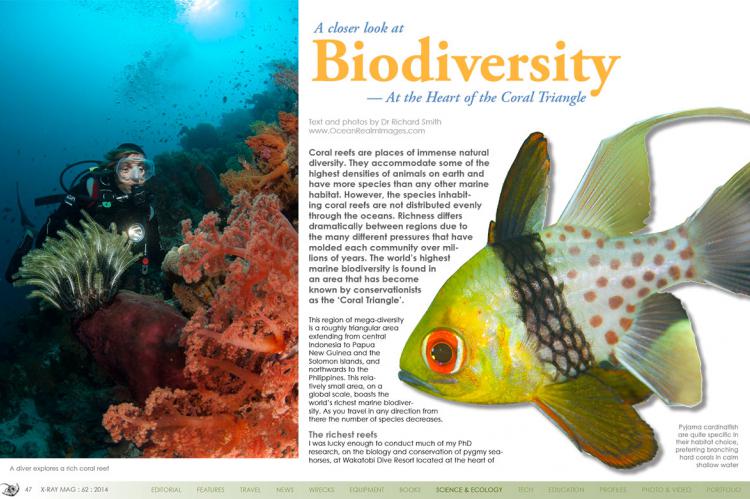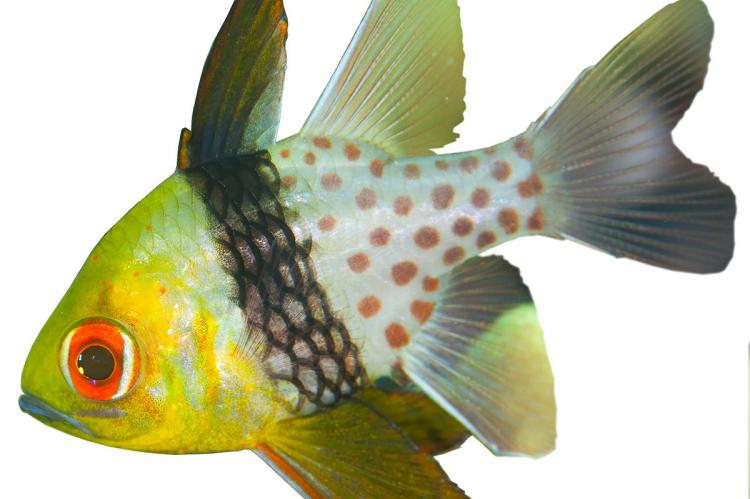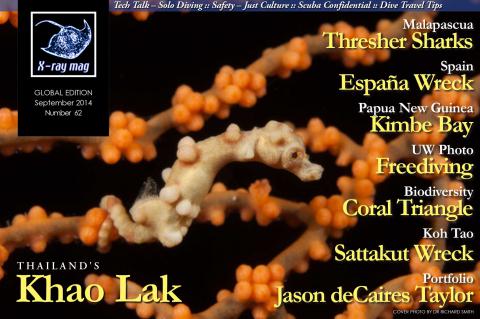Biodiversity on Wakatobi Reef
Coral reefs are places of immense natural diversity. They accommodate some of the highest densities of animals on earth and have more species than any other marine habitat. However, the species inhabiting coral reefs are not distributed evenly through the oceans.
Tags & Taxonomy
Richness differs dramatically between regions due to the many different pressures that have molded each community over millions of years. The world’s highest marine biodiversity is found in an area that has become known by conservationists as the ‘Coral Triangle’.
This region of mega-diversity is a roughly triangular area extending from central Indonesia to Papua New Guinea and the Solomon Islands, and northwards to the Philippines. This relatively small area, on a global scale, boasts the world’s richest marine biodiversity. As you travel in any direction from there the number of species decreases.
The richest reefs
I was lucky enough to conduct much of my PhD research, on the biology and conservation of pygmy seahorses, at Wakatobi Dive Resort located at the heart of the Coral Triangle. For more than six months, over a three-year period, I dived the reefs and really got chance to appreciate the amazingly high biodiversity of this region.
Due to the nature of my work, I spent hundreds of hours in one specific location on the reef and as a result got to know the area like the back of my hand, and the local residents like family.
Over the years I had the opportunity to appreciate the change, or lack thereof, on the reef. Astoundingly over the three years, there was almost no perceptible change in the size of sponges, whips and soft corals in my small overhang on the Wakatobi House Reef. I was constantly amazed that, even after six months, I would still encounter something new almost daily.
One day I found a tiny beige frogfish half the size of my little finger nail, the next a nudibranch I had never seen before crawling across my path and the following evening a bright orange shrimp crept from beneath a sponge. Such is the Coral Triangle, the world’s most biodiverse marine habitat.
Today’s diversity
Today, the two main areas of reef diversity centre on the Caribbean and Indo-West Pacific. The biodiversity in these two areas, however, is quite different: the species richness in the Indo-West Pacific vastly surpasses that of the Caribbean.
The Indo-West Pacific supports at least 600 species of coral and 4,000 fish, compared to 62 and 1,400 species respectively in the Caribbean. The species count for either fish or corals in one Indonesian bay can exceed the number of species found in the entire West Atlantic.
In fact, for the majority of reef organisms there are 10-30% as many species in the West Atlantic as Asia, and no reef-associated fish species are shared between the two bodies of water. Whilst the number of species in the Caribbean appears low, they are in fact entirely different to those of the Pacific due to millions of years of separation.
There is some debate over the explanation for such high Asiatic diversity. One theory is that the area is a hotbed for evolutionary change and species are created here, with some eventually spreading to other regions of the Pacific.
Another possibility is that the ranges of many species from the Indian and Pacific Oceans overlap in the Asian archipelago, causing higher diversity where they coexist. In addition, the geology of the region has origins in many areas, each with their own fauna. The Australian and continental Asian land fragments each contribute their own unique assemblage of organisms.
Whilst the true explanation is probably a combination of these factors, the most simple and palatable reason for high diversity is the huge diversity of habitat types in the Coral Triangle. The profusion of different habitats equals a correspondingly high diversity of organisms to inhabit them: sheltered inner shore habitats have their own set of species, whilst exposed atolls have another.
Beneficially, the Coral Triangle has also avoided the mass extinctions that have blighted other areas over the millennia. Instead, the Coral Triangle has been blessed with long periods of warm, stable conditions fostering the persistence of species.
Fish doctors without borders
Last year I had the opportunity to join Wakatobi’s liveaboard, Pelagian on an itinerary that ventured beyond the resort’s reach and explored other islands in the chain. Whilst the resort has a profusion of different habitats including steep walls, pinnacles, ridges and bays, I had often heard about the muck dives found on Buton island, close to the Sulawesi mainland.
Muck dives are interesting as they host a diverse set of species you are unlikely to see in other habitats, due to their distinct set of environmental conditions. Ghost pipefish, seahorses, frogfish and countless other oddities make this their home. It is a perfect example of the influence habitat diversity can have on overall species richness. The mangrove.
(...)
Download the full article ⬇︎

Originally published
X-Ray Mag #62
Diving Thailand's Similan Islands at Khao Lak; Papua New Guinea's Kimbe Bay; Malapascua Island's Thresher Sharks in the Philippines; The Coral Triangle's Biodiversity; Spain's España Wreck; HTMS Sattakut Wreck at Koh Tao Island; Just Culture; Scuba Confidential; Diving Solo; Freediving for Underwater Photographers; Evie Dudas profile; Interview with artist Jason deCaires Taylor; Plus news and discoveries, equipment and training news, books and media, underwater photo and video equipment, shark tales, whale tales and much more...



